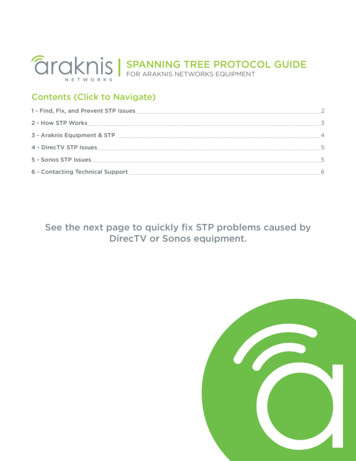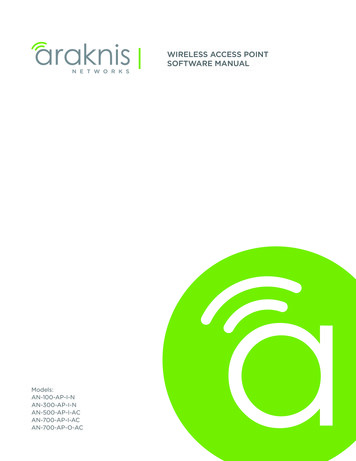
Transcription
SPANNING TREE PROTOCOL GUIDEFOR ARAKNIS NETWORKS EQUIPMENTContents (Click to Navigate)1 - Find, Fix, and Prevent STP Issues22 - How STP Works33 - Araknis Equipment & STP44 - DirecTV STP Issues55 - Sonos STP Issues56 - Contacting Technical Support6See the next page to quickly fix STP problems caused byDirecTV or Sonos equipment.
Finding and Solving STP Issues1 - Find, Fix, and Prevent STP IssuesNote – This guide assumes that all STP settings in the LAN have been left default. Also, you must have amanaged switch installed as the core switch in order to modify STP settings.What Performance Issues Will I Notice?You may notice control system latency when sending commands, slow or no traffic in part or all of the LAN, and/or switch port activity LED indicators flashing wildly or staying on solid.How do I know STP is the Problem?Check the root bridge status in the core switch (Advanced STP Global Settings): Root Bridge Information Root Address – MAC address of currently-elected root bridge device. Basic Setting Bridge Address – MAC address of the switch you are currently logged intoShould be the same valueLower Priority value to fixand avoid issuesIf the fields do not match, then the core switch is not the root bridge, meaning that STP may be causing issues.This means the problem device either has a smaller priority value or a lower MAC address.Fixing and Preventing Issues1.If you aren’t monitoring or changing any other STP settings in the LAN, set the Priority to 4096. This will forcethe core switch to be the elected root bridge and resolve most STP issues.2. If you are customizing STP settings for the LAN, you may need to use a different value. Test throughly aftersetup to ensure that the problem equipment works well with your configuration. Read the rest of this guidefor more information.3. Click Apply to save the new switch settings, then reboot the network and connected devices.4. Log back into the core switch and check the MAC addresses above to ensure that the LAN is now configuredcorrectly. You should see immediate improvement in network performance.Check out the rest of this guide to learn more! 2017 Araknis Networks Page 2/6171103-0950
Finding and Solving STP Issues2 - How STP WorksThis section uses simplified terms and explanations for Spanning Tree Protocol operation within one VLAN. Seethe 210/310 managed switch manual or search online for more detailed information.What is Spanning Tree Protocol?Spanning Tree Protocol (STP) is a Layer 2 protocol that decides the best path for LAN traffic when multipleoptions exist, preventing network loops while guaranteeing redundancy in case of link failure.STP data from each switch is aggregated into a logical map of the LAN, with values assigned to each device andeach link between. The most central switch in the LAN becomes the root bridge, which manages the spanningtree configuration for the network. Then, for any redundant links, the path with the lowest calculated cost isselected and the others are hSwitchRoot BridgeSwitchSwitchSwitchSwitchIn the diagram on the left, the redundant links between switches could cause network loops. Once STP calculates thepath costs and elects a root bridge, the redundant links can be blocked, as shown on the right.How the Root Bridge is ElectedThe switch with the lowest Bridge ID (Bridge Priority MAC address) is elected as the root bridge. The defaultBridge Priority for all Araknis switches is 32768, so if you have three installed, the one with the lowest MACaddress will be selected, which may not be the one we want. This is a good reason to always lower the BridgePriority setting for the core switch.How Paths are Calculated and SelectedWorking out from the Root Bridge, each path’s cost is calculated based on its link speed plus the cost of equipmentand links between itself and the Root Bridge. The best paths are designated for use and remaining paths areblocked from passing any traffic not related to LAN management.Dealing with ChangesSTP data is sent in special data packets called BDPUs. When a change is detected, the spanning tree is recalculatedaccordingly, even selecting a new root bridge if necessary. 2017 Araknis Networks Page 3/6171103-0950
Finding and Solving STP Issues3 - Araknis Equipment & STPBy Series 100/110 Series Unmanaged Switches – Do not support STP configuration, but do pass STP data. Use thesedevices at the edge of the network, connected back to the core switch if possible. 210/300/310 Series Managed Switches – Fully support STP configuration and operation. Araknis managedswitches support three types of STP configuration: 802.1d (STP) – The original protocol for spanning tree. Operates only within one VLAN. We use RSTPinstead because it will still support this protocol. 802.1t (RSTP) – Rapid Spanning Tree Protocol. Known primarily for decreasing response time for topologychanges from 30-50 seconds to less than 10 seconds. Backwards compatible with STP as long as equipmentsupports it. Default setting for Araknis switches. 802.1s (MSTP) – Multiple Spanning Tree Protocol. Enhances RSTP to better support VLANs. Compatiblewith RSTP. This advanced feature is not covered in this guide. See the 210/310 managed switch manual formore information.Best Practices Use Router-On-A-Stick Topology – Place the most powerful managed switch between the router and the restof the LAN to serve as the core switch. Connect additional equipment to the managed switch. Avoid placingunmanaged switches between other switches, only at the edges of the LAN.RouterSwitch CoreManagedSwitchSwitchCustomize Bridge Priority Settings – The easiest way to avoid most STP issues. See 1 - Find, Fix, and PreventSTP Issues for instructions. Core Managed Switch – Set Priority. This will ensure that another system such as sonos or DirecTV won’tbecome the root bridge by mistake. Additional Managed Switches – Use differing Priority values to force the order in which switches wouldtake over as the root bridge in case of failure. Especially important when you have redundant links betweenswitches.Equipment Specific Guidelines – See the rest of the guide for details on the most common issues we encounter,along with ways to solve or prevent them. 2017 Araknis Networks Page 4/6171103-0950
Finding and Solving STP Issues4 - DirecTV STP IssuesNewer DirecTV systems are turning to wired and wireless Ethernet for media distribution, using a master deviceto communicate with secondary slave devices throughout the location. The master device behaves as a switch tocontrol communication and relies on spanning tree features to work correctly.Problems occur because of the way the spanning tree algorithm selects the root bridge for the LAN. DirecTV usesthe same default bridge priority setting as Araknis (32768), which means the device with the lowest MAC addresswill be selected. Since DirecTV has been in business longer than Araknis, all of their MAC addresses are lower thanAraknis MAC addresses.SolutionsThe fix for this issue is simple, just lower the priority of the core switch and force it to be the root bridge. See 1 Find, Fix, and Prevent STP Issues for instructions (requires a managed switch).5 - Sonos STP IssuesSonos is equipped with a standalone, wireless mesh network called SonosNet that links all in-range wirelessSonos devices (that aren’t connected to a Wi-Fi SSID). SonosNet uses STP to prevent redundant links betweenSonosNet devices.Sonos suggests using a single hardwired link between the LAN and the Sonos system, and under these conditions,STP works correctly. However, when multiple Sonos devices are hardwired to different network switches, STP forthe LAN may no longer behave correctly, resulting in issues.This is due to either incorrect STP settings in network switches, or because Sonos is connected to equipment thatdoes not support STP, such as the Araknis router.Solutions Lower the priority of the core switch and force it to be the root bridge. See 1 - Find, Fix, and Prevent STP Issuesinstructions (requires a managed switch). Minimize the number of hardwired Sonos devices. If remote devices won’t stay connected to SonosNet, trymoving them to the Wi-Fi network. Daisy-chain hardwired connections between Sonos devices instead of connecting to the switch. (Only workswith Sonos models equipped with two LAN ports.) Connect all hardwired Sonos equipment to one Araknis switch (not the router). This should eliminate any LANissues caused by Sonos. Even unmanaged 100 and 110 series switches may be used. See the next page fornetwork topology recommendations. 2017 Araknis Networks Page 5/6171103-0950
Finding and Solving STP IssuesSonos Network Topology RecommendationsExample 1 – No STP Setup RequiredAll Sonos devicesconnected to coreswitchRouterRemote device onWi-Fi to preventSonosNet issuesSonosNetWAPOne hardwired linkbetween LAN andSonosNet devicesCoreSwitchSonosSonosExample 2 – STP Setup RequiredSonosNet deviceshardwired to multipleswitchesSonosNet creates asecond link betweenthe switches, forminga network loop.RouterSonosNetSwitchCoreSwitchSonosThe core switch must beset as the root bridgeby lowering its STPpriority valueSonosTopography Notes The diagrams illustrate a router-on-a-stick topology, See Best Practices for more information.6 - Contacting Technical SupportPhone: (866) 838-5052Email: support@araknisnetworks.com 2017 Araknis Networks Page 6/6171103-0950
In the diagram on the left, the redundant links between switches could cause network loops. Once STP calculates the path costs and elects a root bridge, the redundant links can be blocked, as shown on the right. How the Root Bridge is Elected The switch with the lowest Bridge ID (Bridge Priority MAC address) is elected as the root bridge.










